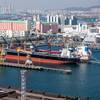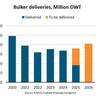The Volvo Penta D9-500 is a robust 9-litre diesel engine with new engine electronics and an innovative turbo. With its 500 hp, compact design and high torque even at low engine speeds it is perfectly adapted for patrol boats, fast fishing boats and other demanding marine applications where fast acceleration, high speed and good comfort are deciding factors.
The D9-500 is an inline-six marine diesel engine with a cylinder volume of 9.4 litres. The engine will be introduced at the SMM marine trade fair in Hamburg when it opens on 28 September 2004.
The new engine is type-approved by leading classification societies and replaces Volvo Penta’s 10-litre engine. The engines are intended for use in high speed coastal applications.
“The demands on service life are tough for commercial engines but we have succeeded in developing an engine with very good acceleration properties and excellent load carrying capacity,” says Gerard Törneman, Head of Product Planning for marine commercial engines at Volvo Penta.
To provide a very fast response from low engine speeds the engine is equipped with a center-mounted “twin-entry turbo” that offers pulse charging. In other words, the power in each exhaust pulse can be used to provide charge pressure. Also the large cylinder volume and electronically controlled unit injectors contribute to the high torque which reaches no less than 1630 Nm already at 1400 rpm.
The D9-500 gives 50 hp more than Volvo Penta’s 7-litre TAMD74 engine. Despite the performance level the D9 requires only marginally more space than the TAMD74 when installed. Since the D9-500 is completely symmetrical, the engine is easy to install even in confined spaces. The engine’s front end is free from service points and it can therefore be mounted right up against the front bulkhead.
The D9-500 has a very robust basic design with a very sturdy engine block, fully cast cylinder head and a special ladder frame bolted tight to the bottom of the engine block. This means not only a long service life and high reliability but also reduced vibrations from the engine and thus good comfort onboard. The generously sized crankshaft with large bearing surfaces also contributes to low vibrations.
The D9-500 is equipped with the EMS2, an electronic engine management system developed by Volvo Penta to meet coming emission requirements. The EMS2 checks and regulates a large number of functions in the engine at high speed. One example is the engine’s fuel demand that is analysed up to 100 times a second. The EMS2 makes sure that the fuel supply is optimally adapted to the current operating conditions. The result is low fuel consumption, minimal exhaust emissions and fast response to the skipper’s commands.
The engine, controls and instruments are integrated in Volvo Penta EVC – Electronic Vessel Control – which results in simple installation and high operational safety. By using CAN bus technology, EVC replaces all traditional cable routing for instruments and controls with a serial data cable. Electronic controls for acceleration and gearbox are standard.
The D9-500 engine’s low exhaust emissions will meet the general environmental requirements for Europe and the USA in the coming years. The D9-500 meets Volvo Penta's very stringent requirements on smoke.
Behind the low emission values lies effective charge-air cooling, high pressure in the fuel injection, the effective gas flow of four-valve technology and electronic engine management.
As is the case with all Volvo Penta engines, the D9-500 has undergone an extensive test programme before being launched. In addition to tests in a laboratory environment, the test programme includes a number of installations in different types of boat – even those in commercial use.
“Before it was launched on the market the D9-500 will have travelled a distance corresponding to 10 trips around the globe,” says Gerard Törneman.
Electronically controlled transmissions with low speed function as an option
The DP-500 is available with different angled-down reverse gears and V-drives. All gears have electronically controlled shifting that is integrated with the engine through the EVC system. The low speed function is available as an option where the transmission slips and reduces the boat speed, which is very useful when maneuvering in a harbor.
Sponsored Content
Safer Starts Here: Build Ships, Protect Crews

July 2025
 Read the Magazine
Read the Magazine

 Read the Magazine
Read the Magazine
This issue sponsored by:

An Unclear Present Danger: The Future of Mine Warfare Is Deception
Subscribe for
Maritime Reporter E-News
Maritime Reporter E-News is the maritime industry's largest circulation and most authoritative ENews Service, delivered to your Email five times per week







